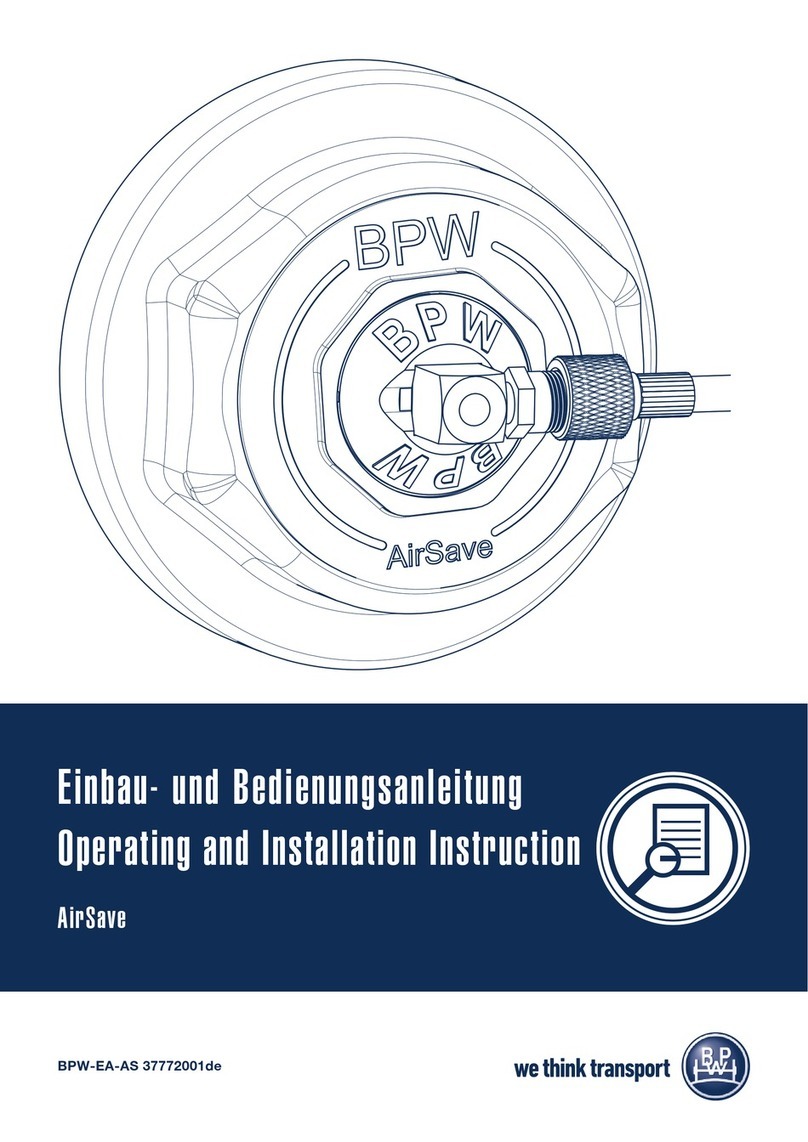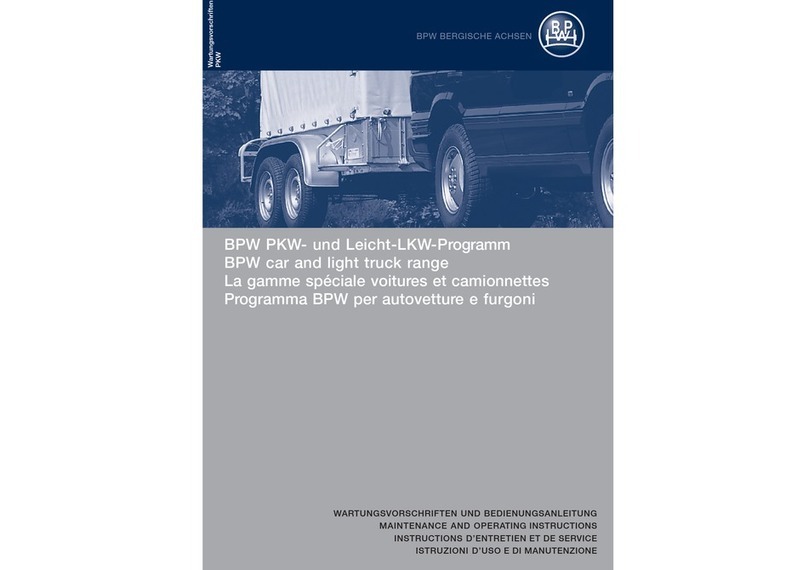BPW ECO Tronic EBS User manual

ECO Tronic EBS.
Operating and Installation Instructions
Version 1.4
BPW · THE QUALITY FACTOR
Operating and Instal-
lation Instructions
Version 1.4

2
BPW Operating and Installation Instructions

3
Table of Contents
Page
1 Introduction
1.1 ECO Tronic EBS 4
1.2 Abbreviations 7
1.3 Safety information 8
1.4 System layout 9
1.5 General components
1.5.1 Location of components in the trailer 10
1.5.2 Primary features of the Modulator 11
1.5.3 ECU connector identification 13
1.5.4 Overview of electrical connections 14
1.5.5 Wiring diagram - 2M 15
1.5.6 Wiring diagram - 3M 16
1.5.7 Overview of pneumatic connections 17
2 Installation options (Configurations)
2.1 Semi and centre axle drawbar trailers
2.1.1 2S/2M and 4S/2M, side by side 18
2.1.2 4S/3M 19
2.1.3 2S/2M + SL, side by side 20
2.2 Drawbar trailers (full trailers)
4S/3M 21
3 Chassis installation
3.1 Mounting of the Modulator
3.1.1 Position without Trailer Roll Stability (TRS) 22
function
3.1.2 Position with Trailer Roll Stability (TRS) 23
function
3.1.3 Identification of ECO Tronic EBS ports 24
and fixing
- Main Modulator
- Additional Modulator
3.1.4 Painting - protected areas 26
3.1.5 Mounting 27
3.2. Electrical wiring
3.2.1 Wiring schematic 28
3.2.2 Wiring diagram 29
3.2.3 Auxiliary equipment wiring 30
3.2.4 General installation recommendations 31
- cabling
3.2.5 General installation recommendations 32
- ISO 7638
3.2.6 General installation recommendations 33
- junction box
3.2.7 POWER / DIAG /Sensor / AUX cabling 34
3.2.8 POWER (ISO 7638) connections 35
3.2.9 POWER (ISO 1185) / 36
Super AUX connections
3.2.10 DIAG connections 37
3.2.11 DIAG / Side of vehicle connection 38
Page
3.2.12 Connectors / Blanking plugs 39
3.2.13 Sensor / AUX plugs 40
3.2.14 Sensor / AUX connections 41
3.2.15 Sensor connections / cabling 42
3.2.16 COLAS®+/ ILAS®-E connections 43
3.2.17 Auxiliary equipment wiring 44
3.2.18 Multimeter measurements 46
4 Piping
4.1 Pipe recommendations 48
4.2 Brake piping layout
4.2.1 2M, 3-axle semi trailer, side by side 50
4.2.2 3M, 3-axle semi trailer 51
4.2.3 3M, 2-axle drawbar trailer (full trailer) 52
4.3 Air suspension system piping layout
Air suspension levelling valve, COLAS®+ 53
and ILAS®-E
5 Operating and installation instructions
5.1 Brake system 54
5.1.1 Coupling heads 55
5.1.2 Trailer Control Module TrCM 56
5.1.3 Trailer Control Module TrCM+59
5.1.4 Brake lining wear sensoring 63
5.2 Air suspension 64
5.2.1 Standard air suspension valve 65
5.2.2 Level adjustable air suspension valve 68
5.2.3 Air suspension valve with zero point 70
adjustment
5.2.4 COLAS®+ 72
5.2.5 ILAS®-E 75
5.2.6 Shut-off cock 77
5.2.7 3/2-ways magnetic valve 78
5.2.8 Steering axle lock application 79
5.3 Soft Docking 80
6 Hazardous Goods / ADR Installations 87
7 Programming 89
8 System diagnostics
8.1 System diagnostics 91
8.1.1 Warning lamp 92
8.1.2 System check procedure 92
8.1.3 Power up ECO Tronic EBS 93
8.1.4 Other errors shown by the warning lamp 93
8.2 Diagnostic Trouble Codes (DTC) 94
9 Recommended maintenance schedule 97

4
Notes on the content
These installation and operating instructions for the ECO Tronic
EBS describe the individual components and functions, as well
as possible configurations. This publication provides assistance
for first installation of an ECO Tronic EBS in a semi trailer,
centre axle drawbar trailer or drawbar trailer (full trailer). It deals
with the configurations 2S/2M, 4S/2M and 4S/3M. As well as
presenting the installation of the ECO Tronic EBS, the document
also discusses possible electrical cablings and provides cable
recommendations. Furthermore, it contains a description of
the extensive options for system diagnosis and fault analysis.
New ECO Tronic product range
ECO Tronic stands for a new product family of intelligent BPW
electronic products in the trailer. The first step is a complete
brake system consisting of, for example, the ECO Tronic EBS,
Trailer Control Module (TrCM), cable sets, Trailer Monitor and
a complete air installation. With the new product range, BPW
has developed its own electronic trailer components so that you
can obtain the entire trailer running gear from a single supplier.
From now on, you will only have one contact for the entire
system. From the axle to the brake, from the air suspension to
the electronic control unit.
The ECO Tronic EBS offers everything that you would expect
from a modern electronic brake system. And much more as
well: this is because in addition to brake control, the ECO
Tronic EBS also offers numerous additional functions. Running
gear data is ready for download at any time, vehicle usage is
recorded and documented, while clever solutions are available
for determining the ideal brake quality – with the new ECO Tronic
EBS from BPW, you can achieve sustainable optimisations in
your fleet management.
Basic functions of an EBS
Companies which want to transport goods from A to B as
safely and efficiently as possible find that an EBS is practically
essential nowadays. This is because EBS offers a whole
range of advantages compared to conventional pneumatic
brake systems: It increases safety due to shorter response
times, thereby reducing braking distances, optimises brake
performance because of improved matching and also simplifies
installation and maintenance processes. These are practical
and commercial advantages with specific benefits, and most
commercial vehicle manufacturers and transport professionals
can no longer do without them nowadays.
In contrast to pneumatically operated brake systems, an EBS
controls the brake cylinder pressure of the disc or drum brakes
individually using electronics. The mechanical pressure applied
to the brake pedal is converted into an electrical signal and
passed on to the control unit. This uses information available
in the data network to calculate the optimum brake pressure,
ensuring that brake forces are optimally distributed throughout
the system. The EBS is connected by a trailer control module
through the CAN interface.
In addition to its straightforward braking function, EBS has driver
assistance functions such as ABS (anti-lock brake system), ALB
(automatic load-dependent braking), as well as a TRS function
(trailer roll stability, not included in the basic kit), thereby offering
additional safety.
What is more, each EBS has a pneumatic fall-back level which
is a statutory requirement for use in emergencies, and permits
conventionally controlled braking in case of an electrical fault.
1.1. ECO Tronic EBS
ECO Tronic is the name of the BPW product range
for electronic trailer components.
The first product is the ECO Tronic EBS with
special trailer-specific features.
ECO Tronic EBS means BPW is the system
supplier with overall responsibility for the intelligent
trailer running gear.
1. Introduction

5
1.1. ECO Tronic EBS
Features of ECO Tronic EBS
The core of the ECO Tronic EBS is the EBS Modulator. Its
compact dimensions mean that it can be installed without
difficulty in all current semi trailers, drawbar trailers (full trailers)
and centre axle drawbar trailers. Its enclosed design ensures
fault-free operation and consists of a corrosion-resistant plastic
module and a weatherproof die-cast aluminium module.
All cable connections of the ECO Tronic EBS are grouped
together on one level for a clear layout, thereby permitting
optimum access. In addition, ease of installation is ensured by
connection designations on the side and the lid of the housing.
The ECO Tronic EBS can be used in a wide range of applications
with its five AUX connections. There is a user-configurable
Super AUX connection available as an option which gives
up to three more functions. Furthermore, the housing has an
integrated quick release valve for the parking brake and two
test connections for pressure gauges.
The numerous basic functions provided as standard mean the
ECO Tronic EBS offers greater safety and convenience. This
includes practical features such as stability control, lifting axle
control or steering axle lock which soon pay their way in day-
to-day operations.
Trailer Roll Stability
In the background, there is an electronic safety system for the
trailer which automatically intervenes in critical driving situations
to provide stability. Sensors integrated in the EBS permanently
measure the lateral acceleration of the trailer for this purpose. If a
critical driving situation is reached then the trailer is immediately
braked. As a result, the risk of skidding and tipping over - e.g.
when cornering or due to a shifting load - is reduced to a
minimum thanks to Trailer Roll Stability.
Lifting axle control
Another practical performance feature of EBS is the automatic
function for lifting and lowering a lifting axle depending on the
load and speed. This allows you to benefit from a significant
convenience feature compared to manual lifting axle operation,
and also reduces your running costs. Using an axle lift reduces
tyre wear when unladen. It goes without saying that the lifting
axle control can be switched over to manual operation on
request at any time, e.g. if the lifting axle is required as a
manoeuvring aid or starting traction control, or when the trailer
needs to be put onto the dynamometer test rig.
Automatic steering axle lock
The basic functions of EBS also include the automatic steering
axle lock. This is activated when reversing and automatically
blocks deflection of the wheels on the trailer’s steering axle.
Automatic service brake activation
In conjunction with an extendable drawbar installation,
automatic actuation of the service brake reduces the gap
between the vehicles, thereby allowing for convenient through-
loading. The ideal solution for greater safety and operating
convenience at the loading ramp.
Safety braking
This EBS function automatically applies the brakes on vehicles
such as tankers when the instrument cabinet is open, therefore
preventing it from moving off. This is a sensible additional feature
because it ensures that lack of attention does not immediately
become a danger.
Paver brake function
This is the perfect EBS function for ensuring the correct distance
between the paver machine and the trailer during road building.
In this case, the paver machine pushes the braked trailer in front
of it, thereby optimising handling and the production process.
Table of contents
Other BPW Automobile Accessories manuals
Popular Automobile Accessories manuals by other brands

ULTIMATE SPEED
ULTIMATE SPEED 279746 Assembly and Safety Advice

SSV Works
SSV Works DF-F65 manual

ULTIMATE SPEED
ULTIMATE SPEED CARBON Assembly and Safety Advice

Witter
Witter F174 Fitting instructions

WeatherTech
WeatherTech No-Drill installation instructions

TAUBENREUTHER
TAUBENREUTHER 1-336050 Installation instruction














